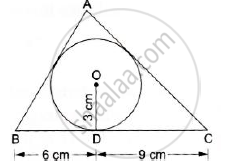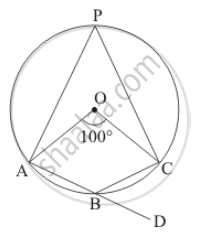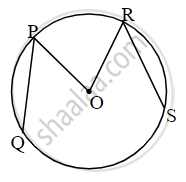Advertisements
Advertisements
Question
A triangle PQR is drawn to circumscribe a circle of radius 8 cm such that the segments QT and TR, into which QR is divided by the point of contact T, are of lengths 14 cm and 16 cm respectively. If area of ∆PQR is 336 cm2, find the sides PQ and PR.
Solution

Here, T, S and U are the points of contact of the circle with the sides QR, PQ and PR, respectively.
OT = OS = OU = 8 cm (Radii of the circle)
We know that the lengths of tangents drawn from an external point to a circle are equal.
∴ QS = QT = 14 cm
RU = RT = 16 cm
PS = PU = x cm (say)
So, QR = QT + TR = 14 cm + 16 cm = 30 cm
PQ = PS + SQ = x cm + 14 cm = (x + 14) cm
PR = PU + UR = x cm + 16 cm = (x + 16) cm
Also, the tangent at any point of a circle is perpendicular to the radius through the point of contact.
∴ OT ⊥ QR, OS ⊥ PQ and OU ⊥ PR
Now,
ar(∆OQR) + ar(∆OPQ) + ar(∆OPR) = ar(∆PQR)
\[\therefore \frac{1}{2} \times QR \times OT + \frac{1}{2} \times PQ \times OS + \frac{1}{2} \times PR \times OU = 336 {cm}^2 \]
\[ \Rightarrow \frac{1}{2} \times 30 \times 8 + \frac{1}{2} \times \left( x + 14 \right) \times 8 + \frac{1}{2} \times \left( x + 16 \right) \times 8 = 336\]
\[ \Rightarrow 120 + 4x + 56 + 4x + 64 = 336\]
\[ \Rightarrow 8x + 240 = 336\]
\[\Rightarrow 8x = 336 - 240 = 96\]
\[ \Rightarrow x = 12\]
∴ PQ = (x + 14) cm = (12 + 14) cm = 26 cm
PR = (x + 16) cm = (12 + 16) cm = 28 cm
Hence, the lengths of sides PQ and PR are 26 cm and 28 cm, respectively.
APPEARS IN
RELATED QUESTIONS
In the given figure, a triangle ABC is drawn to circumscribe a circle of radius 3 cm such that the segments BC and DC into which BC is divided by the point of contact D, are of
lengths 6cm and 9cm respectively. If the area of 2 ΔABC = 54cm2 then find the lengths of sides AB and AC.

If the difference between the circumference and the radius of a circle is 37 cm, then using`22/7`, the circumference (in cm) of the circle is:
In the given figure, O is the centre of the circle. Find ∠CBD.

In a cyclic quadrilateral ABCD if AB || CD and ∠B = 70°, find the remaining angles.
In the given figure, if chords AB and CD of the circle intersect each other at right angles, then x + y =
ABC is a right triangle in which ∠B = 90°. If AB = 8 cm and BC = 6 cm, find the diameter of the circle inscribed in the triangle.
Draw a line AB = 8.4 cm. Now draw a circle with AB as diameter. Mark a point C on the circumference of the circle. Measure angle ACB.
A line segment joining any point on the circle to its center is called the _____________ of the circle
In figure, O is the centre of a circle, chord PQ ≅ chord RS. If ∠POR = 70° and (arc RS) = 80°, find
(i) m(arc PR)
(ii) m(arc QS)
(iii) m(arc QSR)

Assertion (A): If the circumference of a circle is 176 cm, then its radius is 28 cm.
Reason (R): Circumference = 2π × radius of a circle.
